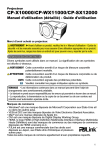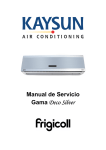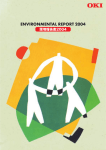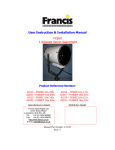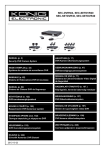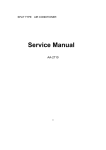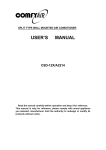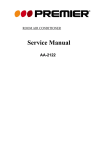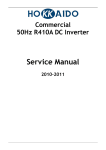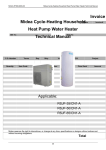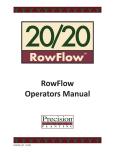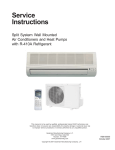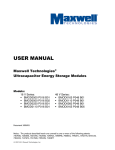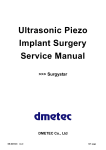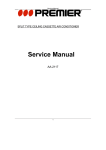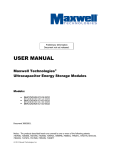Download Service Manual
Transcript
SPLIT TYPE WALL MOUNTED AIR CONDITIONER Service Manual AA-2119 Service Manual CONTENTS 1. Range & Conditions ..................................................................................... 2 1.1 Operating Range .......................................................................................................... 2 1.2 Operating Conditions................................................................................................... 2 2. Specifications ............................................................................................... 3 2.1 Unit Specifications ....................................................................................................... 3 2.2 Specifications of main parts........................................................................................ 4 2.3 Specifications of other parts ....................................................................................... 6 3. Control Specifications ................................................................................. 7 3.1 System source.............................................................................................................. 7 3.2 Control functions ......................................................................................................... 7 3.3 Operating mode............................................................................................................ 8 3.4 Protection function .................................................................................................... 10 3.5 Other functions........................................................................................................... 12 3.6 Parameter table .......................................................................................................... 14 4. Dimensional Data ....................................................................................... 15 5. Performance Charts ................................................................................... 18 6. Refrigerant Flow Diagram.......................................................................... 19 7. Circuit Diagram........................................................................................... 20 7.1 Electrical wiring diagram for outdoor unit ............................................................... 20 7.2 Electrical wiring diagram for indoor unit ................................................................. 20 8. Troubleshooting ......................................................................................... 21 8.1 Check before troubleshooting .................................................................................. 21 8.2 The air conditioner does not work............................................................................ 22 8.3 Some parts of the air conditioner do not work ........................................................ 24 8.4 Air conditioner operates, but abnormalities are observed ..................................... 26 8.5 Sensor is defective (Check reference 3.4.8)............................................................. 27 9. Checking Electrical Components.............................................................. 27 9.1 Measure insulation resistance .................................................................................. 27 9.2 Checking continuity of fuse on PCB Ass'y .............................................................. 28 9.3 Checking motor capacitor ......................................................................................... 28 1 Service Manual Technical Data 1. Range & Conditions 1.1 Operating Range Operating Modes Temperature Indoor Temperature Outdoor Temperature Max. 32℃ DB/23℃ WB 43℃ DB Min. 21℃ DB/15℃ WB 21℃ DB Cooling 1.2 Operating Conditions Rated Operating Conditions Cooling Indoor Temperature Outdoor Temperature 27℃ DB/19℃ WB 35℃ DB/24℃ WB Tubing Length (m) 4.0 Max. Operating Value Indoor Temperature Cooling Outdoor Temperature 32℃ DB/23℃ WB Tubing Length (m) 43℃ DB 4.0 DB: Dry-bulb temperature WB: Wet-bulb temperature 2 Service Manual 2. Specifications 2.1 Unit Specifications 220V/ 60Hz (single phase) Rated voltage & Power Performance Cooling Rated capacity Air circulation (High) Moisture removal (High) Btu/h m3/h L/h 9000 420 1.1 Cooling Electrical rating Voltage range Operating current Power input E.E.R V A W W/W 198~242 4.80 1000 2.64 Features Controls / Temperature control Control unit Timer Fan speed Airflow direction Indoor /Outdoor Horizontal Vertical Air filter Compressor Refrigerant Refrigerant control /g Indoor dB-A Outdoor dB-A Pipeline connection manner Max. pipeline length m Refrigerant tubing Narrow tube mm diameter (in) Wide tube mm Noise Dimensions & Weight Microprocessor / I.C thermostat Infrared remote control transmitter KK22B OFF 8 hours High, Medium, Low, Auto / Auto (single speed) Manual Remote control Anti-mold, washable Rotary-type (Hermetic) R22 /550 Capillary tube 39 50 Flare 9.0 6.35 (1/4”) 9.52 (3/8”) Indoor unit Outdoor unit Height mm 245 430 Unit dimensions Width mm 760 600 Depth mm 183 245 Package dimensions Height Width mm mm 305 845 515 735 Depth mm 253 340 Net weight kg 7.5 22 Gross weight kg 9.5 26 Weight Data subject to change without notice 3 Service Manual 2.2 Specifications of main parts 2.2.1 Indoor unit AA-2119 CHZ22G/M1S or CHZ22G/M1S-K Controller Part No. CHZ25G/YS Controller Microprocessor Fuse T3.15A, 250V KK22B-C1 (English status) Remote controller Fan & Fan motor Type Cross-flow fan Quantity / Diameter / Length mm 1/ф97/583 Fan motor model RPS19H-8(Welling) Pole / Rotation of motor 4/1260 (rpm, 220V High speed) Grey-White: Coil resistance Ambient temp 20℃ 507 White -PINK: 85.5 Ω 1μF / 450 VAC Operating capacitor Front panel motor Type Step motor Model 24BYJ48-Q1 Rated voltage (d.c.) V Coil resistance (Ambient temp 25℃) 12 Ω 300Ω±7% Heat exchanger Fin Aluminum fin / Copper tube Rows Fin pitch Face area 1.5 mm 1.5 2 m ---- Data subject to change without notice 4 Service Manual 2.2.2 Outdoor unit Compressor Type Rotary(Hermetic) Compressor model Huarun: C-1RT142H01AA Compressor power input W 985 Compressor oil / Amount CC SAY-56T/ 350 Overload protector (external) B240-155-241E Compressor locked rotor amperes A Coil resistance (Ambient temp 20℃) Ω Operating capacitor 24 C-R: 2.75 C-S: 4.55 μF 25 VAC 450 Fan & Fan motor Type Propeller fan Amount / Diameter mm Fan motor model Welling:YDK36-6D-5 Pole / Rotation of motor (220V,High speed) rpm Rated power output W Coil resistance (Ambient temp 20℃) Ω Safety device 1/ф320 Type 6…990 36 White – Gray: 202 Brown–White:134 Internal protector Operating Open ℃ 130±8 temp Close ℃ 90±15 μF 2.5 VAC 450 Operating capacitor Heat exchanger Fin Aluminum fin / Copper tube Rows 1.0 Fin pitch mm 2 Face area m 1.6 ---Powder-spraying coating External coating Data subject to change without notice 5 Service Manual 2.3 Specifications of other parts Indoor unit Transformer (TR) DB48-220-A2214 Thermal resistor KTM-41-C9(Copper), KTEC-41-C12(Plastic) 0℃ Resistance( KΩ) Power supply 32.97KΩ 20℃ 12.51KΩ 30℃ 8.048KΩ 10℃ 20.00KΩ 25℃ 10.00KΩ JUZ6.604.270 16A/ 250Va.c Power relay (PR) G4A-1A-E 12VDC Or JQX-102F-012 Coil rated voltage Coil resistance Ω(20℃) JZC-32F-012-1H1 12V d.c 12V d.c 200Ω 300Ω Data subject to change without notice 6 Service Manual 3. Control Specifications 3.1 System source 3.1.1 Signal input Temperature sensor signal (indoor temperature -35~130℃, indoor coiled temperature -35~130℃, outdoor coiled temperature -35~130℃(optional)); remote control signal; emergency switch input; (capacity, heating or cooling) input. 3.1.2 Signal output Display signals (SI, SCK, RCK or air refresh, operation, pause,timer); louver motor (1a, 1b, 1c, 1d); indoor fan speed ( high, medium, low) output, AUH, air refresh, buzzer, compressor, outdoor fan motor, 4-way reversing valve and other assistant functions. 3.2 Control functions 3.2.1 Switches input Press the Emergency button on the panel when the air conditioner is in the off mode, then the unit will be turned on and work in the “SMART” mode. Press this button again when the unit is running (including test run or in “SMART” mode), the air conditioner will be turned off. Note: All the displaying will disappear when turn off the air conditioner by pressing the Emergency button. 3.2.2 Timing off “Timing off ” function is only effective when the air conditioner is running. The indoor unit will display “ TIMING” when this function is effective. The unit will be turned off at the set time and “ TIMING” signal will disappear. When the user turn off the unit ahead of the set time by remote controller or Emergency button, the “Timing off” function will be canceled. Note: The set time for Timing off is 1-8 hours. 3.2.3 Sleep mode When the sleep mode is set, the set temperature will increase 1℃ after running 1 hour in cooling or Dehumidifying mode. Temperature will decrease 1℃ after running 1 hour in heating mode. Note:Display set temperature is unaltered When the air conditioner runs in sleep mode, the Max. indoor fan speed is set at medium level. Note: The fan speed is set to be at low level, but the fan speed will turn into medium level when in freeze-prevention mode. 7 Service Manual 3.2.4 Blowing surplus energy function The indoor unit will continue run in low fan speed no longer than 30 seconds after the unit is turned off when in the heating operation. (Note: Except the AUH blows surplus energy function, the unit will stop blowing surplus energy when the temperature of tube is below 35℃.) 3.2.5 Operation for dryness enzyme-prevention When the unit is turned off in cooling mode, the indoor unit will continue run in low fan speed for about 3 minutes to remove the partial moisture in the room. 3.3 Operating mode 3.3.1 SMART operation The unit will judge the operation mode automatically after receiving the SMART signal. 3.3.1.1 When Tr≥24℃, turns on the unit in the original condition, the unit will turns into cooling mode. When 20℃<Tr<24℃, the unit will turns into airflow mode. When Tr≤20℃, the unit will turns into heating mode. In airflow mode, when in the condition that it is necessary for cooling or heating more than 1 minute, the unit will turn into cooling or heating mode. 3.3.1.2 The fan speed is at auto mode and adjustable, the display will change accordingly. Note: If choosing the airflow mode, the auto airflow is set to be at low level automatically. 3.3.1.3 The airflow direction is swing and adjustable, and the display will change accordingly. 3.3.1.4 All output (air refresh, AUH, air ventilate, etc.) is effective. 3.3.1.5 In cooling mode, the original set temperature is Ts=Tr-5℃ and 22℃≤Ts≤27℃, then the master unit will not change operation mode when the unit enters into cooling mode. If users want to change working condition by remote controller, in case the condition will not conflict with the master unit mode, ( such as cooling mode conflicts with AUH mode), the master unit will operate and display in new condition set by remote controller. 3.3.2 Cooling Temperature control range: 16℃-32℃; Original value: 24℃; Temperature control precision: ±1℃; Characters on control: 4-way reversing valve closes: When Tr≥Ts+1℃, compressor runs; When Tr≤Ts-1℃, compressor stops; The control circuit will stop compressor only after it has run at least 5 minutes. The compressor can be restarted 3 minutes later the turn-off. Fan speed control: Auto: When Tr>Ts+2℃, high speed; When Ts< Tr≤Ts+2℃, medium speed; 8 Service Manual When Tr≤T, low speed. Manual: Users can select the fan speed of high, medium or low level as needed when the air conditioner is in the turn-on status. Louver adjustment: Manual (vertical direction): Set the blades position as needed. (Position 1-5 in figure 1.) Auto (vertical direction): The range of sweeping is in position 2-5, swinging speed is 5 degree/second. 3.3.3. Dehumidification Temperature control range: 16℃-32℃; Temperature control precision: ±1℃; Characters on control: 4-way reversing valve closes. When Tr≥Ts+2℃,the running mode is the same to the cooling operation; When Ts-1℃< Tr < Ts+2℃, compressor and outdoor fan motor run continuously. And indoor fan motor runs at low fan speed When 15℃< Tr < Ts-1℃, compressor and outdoor fan motor are working according to 3 minutes working alternating with 9 minutes stopping. Indoor fan motor runs at low fan speed when compressor is running, and it runs at breeze level for 30 seconds later the turn-off of compressor. 30 seconds later, fan motor will turn off. When Tr≤15℃, indoor and outdoor fan motor will stop running, louver blades (vertical direction) can’t be controlled. Note: Among four dehumidification modes, if users want to change running condition, then the unit must run for at least 3 minutes or in off-status for at least 3 minutes. Louver adjustment (vertical direction): The range of sweeping is in position 2-5, the fan speed is 5 degree/second. 3.3.4. Heating (not available for cooling-only type air conditioner) Temperature control range: 16℃-32℃; Original value: 24℃; Temperature control precision: ±1℃; Characters on control: 4-way reversing valve opens. When Tr≤Ts-1℃, compressor, 4-way reversing valve and outdoor fan motor all open. When Tr≥Ts+1℃, compressor and outdoor fan motor both close; Indoor fan motor is running at low level. When Trc (Trc: The indoor coiled temperature) <F℃, the air conditioner will enter into cool-airflow-prevention operation, the PAUSE indicator will light. indoor Fan motor control: Manual: Users can select the fan speed of high, medium or low level as needed. Auto: When Tr< Ts-2℃, high speed; When Tr≥Ts-2℃,medium speed; Louver adjustment: Manual (vertical direction): Set the blades position as needed. (Position 1-5 in figure 1.) Auto (vertical direction): The range of sweeping is in position 1-4, fan speed is 5 9 Service Manual degree/second. Compressor control: The control circuit will stop compressor only after it has run at least 5 minutes. Compressor can be restarted 5 minutes later the turn-off. 5 4 3 2 1 Fig.1 3.4 Protection function 3.4.1 Delay-starting protection for the compressor Compress will restart working 3 minutes(5 minutes in HEAT mode) later the turn-off of compressor or power-off to keep the pressure balance of the cooling system. 3.4.2 Freeze-prevention: To prevent indoor heat exchanger freezing in cool and dry operation. When Trc≤3℃ for 2 minutes, the air conditioner will enter freeze-prevention operation. If indoor fan speed is at low or breeze level, it will turn to medium speed automatically; if indoor fan speed is at medium speed, it will turn to high speed;, The air conditioner will exit Freeze-prevention operation when Trc>8℃, indoor fan motor runs at the set fan speed. Compressor will stop running when it runs at least 10 minutes and Trc≤-2℃. If the off-time of compressor is for more than 6 minutes or Trc≥8℃, and the compressor stops running for more than 3 minutes. Compressor and outdoor fan motor will restart working. The air conditioner will exit Freeze-prevention operation, and indoor fan motor is running at the set speed. Note: When entering Freeze-prevention operation, users can adjust louver position, fan speed, the set temperature. 3.4.3 Dew- prevention (cooling&dehumidification mode) When the louver blades are at the position 5 as shown in Fig.1 for at least 15 minutes, the blades will come back to 4 position automatically( if in the 1 position, it will come back to 2 position) and the blades will come back to the original position.(Note: There would be no dew-prevention when at high airflow level. 3.4.4 Cool-airflow-prevention: (not available for cooling-only type air conditioner) In heating operation, compressor do not work longer than 5 minutes. A.If Trc<F℃, inner fan motor will stop. B.F℃<T, pipe temp.≤36℃, the indoor fan motor will run at low speed. C.T pipe temp.>36 ℃, the indoor fan motor will run at set speed. Note: As long as comes into A condition, the unit will not enter A condition even if temp. 10 Service Manual drops. As long as comes into C condition, the unit will not enter B condition even if temp. drops. Louver blades will come to 5 position automatically and not controllable. During cool-airflow-prevention period, pause (red) indicator will light. 3.4.5 Heating overload working (not available for cooling-only type air conditioner) When Trc≥A℃, the unit enters heating overload protection. If indoor fan speed is set at low or breeze level, it will turn to medium speed automatically; if indoor fan speed is set at medium speed, it will turn to high speed; When Trc≥B℃, outdoor fan motor stops. When indoor pipe temp. drops to D℃, outdoor fan motor will restart working. Air conditioner will exit overload protection when Trc drops to E℃, compressor restarts working, Indoor fan motor runs at the set fan speed. When Trc≥C℃and the build-up time of compressor running is for more than 5 minutes, compressor will be stopped. Note: When entering heating overload operation, users can adjust louver position, fan speed, and the set temperature. 3.4.6 Defrosting: (not available for cooling-only type air conditioner) 3.4.6.1 Defrost entry conditions Judge defrosting condition after the compressor running for more than 10 minutes. Defrost entry conditions for the unit with outdoor pipe temp. sensor A. Indoor unit enters overload prevention and outdoor unit stops. When outdoor fan motor runs for more than 10 minutes, and the build-up time of compressor running is for more than 50 minutes, Trc≤A-1℃ and Toc≤-2℃( Toc: The outdoor coil temperature.) B. Not overload, but Toc≤-17℃ for 30 seconds. The build-up time of compressor running is for more than 25 minutes. C. The build-up time of compressor running is for more than 3 hours. And Toc≤-2℃ for 5 minutes. Trc≤G-2℃ and Trc≤(Tr+H)℃. D. The build-up time of compressor running is for more than 1.5 hours. And it reaches the condition of the unit stopping. Toc drops blow -2℃ for 3 minutes(overload).or Toc≤-2℃ and Trc≤G+2℃ (not overload). E. The build-up time of compressor running is for more than 50 minutes.Toc ≤-2℃, Trc drops at least 3℃ and Trc≤G℃, Trc≤(Tr+H) ℃. F. Toc ≤-2℃, the temperature decreases 1℃ every 6 minutes (repeat for 3 times). The build-up running time is for more than 25 minutes. Defrost entry conditions for the unit without outdoor pipe temp. sensor A. .Indoor unit enters overload prevention and outdoor unit stops. When outdoor fan motor runs for more than 10 minutes, and the build-up time of compressor running is for more than 50 minutes, indoor pipe temp. is below L℃. B. When the build-up time of outdoor fan motor is more than 3 hours, and indoor pipe temp. is below I ℃. 11 Service Manual C. When arriving at off condition, the build-up time of compressor is more than 1.5 hours, and indoor pipe temp. is below M ℃.( below N℃ when in overload protection) D. The build-up time of compressor is more than 50 minutes, Trc drops more than 3℃ and Trc≤I℃,Trc-Tr≤K℃; E. When not overloading, Trc drops 1℃ every 6 minutes and repeat 3 times continuously, the build-up time of compressor is more than 25 minutes. Users can defrost as long as the unit meet one of the above condition. 3.4.6.2 Defrosting Compressor, indoor and outdoor fan motor will stop working after the unit entering defrosting running. 5 5seconds later, 4-way reversing valve will close. Another 5 seconds, compressor starts running. When the time of the compressor running is for more than 8 minutes or Toc≥20℃, and defrosting time is at least for 3 minutes, Compressor stops. 55 seconds later, 4-way reversing valve will open. Another 5 seconds later, compressor and outdoor fan motor will restart working and exit defrosting operation. In defrosting operation, the time of compressor running is at least 3 minutes. Cool-airflow-prevention and blowing residue heat are both effective. 3.4.7 Testing codes code 1: to set test run; code 2: to set fast testing; code 3: to set auto-diagnosis; code 4: to cancel the above setting; There only can be one setting each time in the tests above. 3.4.8 Temperature and failure code display A. The defining of code refers to the following: Code 11: room temperature code 12: indoor coil pipe temperature Code 13: outdoor coil pipe temperature B. Code 14: abnormal information E0: Normal operation P2: Heating overload F1: The circuit of room temperature sensor is damaged or abnormal C.The circuit of room temperature sensor is abnormal---Pause light flashes and the unit stops. D. The circuit of pipe temperature sensor is abnormal---Timer light flashes and the unit can not run in heating mode. E. When outdoor pipe temp. sensor is failure Defrost entry conditions for the unit without outdoor pipe temp. sensor 。 3.5 Other functions 3.5.1 Auto-diagnosis The Auto-diagnosis functions are in the following steps when the power is turned on. Buzzer beeps 1s →Running compressor on 0.5s →Running outdoor fan on 0.5s → 4-way reversing valve 0.5s →AUH 0.5s →low fan speed on 0.5s →medium fan speed on 12 Service Manual 0.5s →high fan speed on 0.5s →step motor for louver(1a,1b,1c,1d)on 0.5s→no output for 0.5s →output for 0.5s→ Buzzer beeps 1s →……. During the period of auto-diagnosis, LED display screen is light all the time. During the period of auto-diagnosis, buzzer will keep beeping if temperature sensor is abnormal.(except outdoor temperature sensor) 3.5.2 Timer saving: The master controller CPU runs as 61 times as the former speed. (there is no timer saving function within 1 minute) 3.5.3 AUH Starting conditions for AUH a. Receive starting AUH signals from remote controller. b. In the heating mode. c. The build-up time of compressor is more than 1 minute. d. Tr≤18℃ e. Ts-Tr≥3℃ f. Indoor fan motor is running at medium or high level. B. The AUH function will be closed when meets any of the following conditions: a. Ts-Tr≤2℃ b. Trc≥A-2 c. Indoor fan motor stops running or runs at low level. d. Entering defrost running. e. Receive signals for closing AUH from remote controller. Note: If AUH stops working because of condition b, users can restart AUH only on condition that pipe temp. ≤D-1℃ and meet all conditions in A. C. Defrost when AUH is in operation If AUH is in operation or less than 10 minutes after closing, indoor fan will continue running at low level for 30 seconds when entering defrosting. D. Switch off unit when AUH is in operation. If AUH is in operation or less than 10 minutes after closing, indoor fan will continue running at low level for 30 seconds when switching off. The other things are the same to the condition when switching off normally. A. 3.5.4 LCD display The LCD doesn’t display symbols if air conditioner is in off status, but in the checking and setting conditions, the LCD will also display the corresponding state of the unit. Turn on the master unit, the LCD only display run indicator after 30 seconds. The LCD will display all setting if remote control signal is received again, and only display run indicator after receiving the last signal from remote controller 30 seconds later. 3.5.5 Air refresh function(not available for type A) Press air refresh button when the unit is in off status, the unit will switch on. Indoor fan motor runs at the set fan speed, air refresh output. When air refresh function is turned off, 13 Service Manual the unit will turn back to the original mode. Press air refresh button if Air conditioner is running, air refresh will be functioned and the indicator will light 3.5.6 Quiet Operation Press air refresh button when air conditioner is in off status and set fan speed as quite mode, the indoor fan will run at breeze; In other status, the indoor fan runs at breeze. 3.5.7 Restoration function (optional) To install E2PROM, users do not have to program and assemble. As long as installing E2PROM, the unit will have the restoration function after electricity comes again. 3.5.8 The second function button The second function for “AIR REFRESH” button: Press “AIR REFRESH” button and hold on, and finish the test condition after 5 seconds. When entering this mode, the original display is 0 for each entry. The second function is only effective for temperature control button, on/off button, and air refresh button. Other buttons are not effective for the second function. The second function for “AUH” button: Press “AUH” button and hold on for 5 seconds, the unit will enter dew-prevention function. At the same time, the unit gives a buzz sound. This button is only effective in cooling and heating mode. Users can set or cancel this function by press this button. 3.6 Parameter table Temperature table of protecting point MODEL A B C D E F G H I J K L M N AA-2119 49 52 65 44 42 32 36 24 48 37 19 48 39 48 The type of remote controller for cooling-only air conditioner is KK22B-C1. 14 Service Manual 4. Dimensional Data Indoor unit Outdoor unit The above figures are only schematic, and they may be slightly different from the actual appliances you bought. 15 Service Manual Exploded view for indoor unit 16 Service Manual Exploded view for outdoor unit 17 Service Manual 5. Performance Charts Operation current(A) Cooling Indoor inlet temp.(DB)(℃) Outdoor inlet temp.( Note: ●……Points of rated operating conditions 18 )(℃) Service Manual 6. Refrigerant Flow Diagram Thermal insulating of refrigerant pipeline To prevent heat loss and condensed water from dropping on the floor, the wide and narrow tube of air conditioner should be wrapped with thermal insulating materials. For using capillary tube, and the tubes are in low temperature, the thickness of thermal insulating materials shall be more than 8 mm. 19 Narrow tube Ф6.35 mm(1/4”) Wide tube Ф9.52 mm(3/8”) Service Manual 7. Circuit Diagram 7.1 Electrical wiring diagram for outdoor unit Warning To avoid electrical shock hazard, be sure to disconnect power before checking, servicing and/or cleaning any electrical parts. 7.2 Electrical wiring diagram for indoor unit 20 Service Manual 8. Troubleshooting 8.1 Check before troubleshooting Warning: High-voltage will result in electric shock or death. Always cut off the power before checking and maintaining. 8.1.1 Check power line To check whether the power line is connected correctly to the terminal No 1 which is on the terminal block of the indoor unit Brown 1 2 3 Blue N 1 N 2 Yellow/Green 4 5 8.1.2 Check unit wiring To check whether the inter-unit wires are connected correctly. 8.1.3 Check power supply To check whether the power supply is in the specified range (220-240V). 8.1.4 Check connector and lead wire of indoor and outdoor units. To check whether the insulating cover of the lead wire is damaged. To check whether the lead wire and the connector are connected well To check wires. 21 Service Manual 8.2 The air conditioner does not work 8.2.1 Leakage protector is open or fuse is burnt. A. Setting leakage protector to “ON”, it opens immediately (can not reset). There is possibility of ground fault. Check insulation resistance (The insulation resistance shall be more than 2MΩ). B. Leakage protector is OFF. Disconnect unit wires from terminal block of outdoor unit. And measure No insulation Poor insulation performance Measure the insulation resistance of resistance of outdoor unit. the electric parts of outdoor unit. Disconnect unit wires from terminal block of No indoor unit. Unplug the unit and measure Poor insulation performance Measure the insulation resistance of the insulation resistance of indoor unit. the electric parts of outdoor unit. C. The fuse is open in several minutes after turning air conditioner on. No Check the rated power of fuse. Replace it with a proper one Yes No Check the resistance of indoor fan motor coil. Replace indoor fan motor. Yes No Check the resistance of transformer coil. 22 Replace transformer. Service Manual 8.2.2 The indoor and outdoor units do not work. No Check power supply. 2. Check the breaker. Yes Check if something residue 1. Power failure cover on Yes transmitting part of the remote controller. Clean it. No Yes Check if infrared receiver on indoor unit is dirt. Clean it. No Check fuse on indoor PCB Ass’ y. Yes Check the resistance of indoor fan motor coil. No Measure the resistance of compressor coil. Parts of indoor PCB Ass’ y or switches are defective. Measure the resistance of power transformer. 8.2.3 Only outdoor unit does not work. Check the set .The set temperature is too high in cooling. Yes Adjust the set temperature temperature No Measure the voltage between terminal No.1 and No.2 on the terminal block (220-240V) No voltage indication PCB Ass’ y of indoor unit is defective. 8.2.4 Indoor unit does not work. Indoor PCB Ass’ y is defective. 23 Ok Outdoor unit is defective. Service Manual 8.3 Some parts of the air conditioner do not work 8.3.1 Only indoor fan does not work. Not rotate Check if foreign matter is in Check the fan rotation the fan cover. Ok Measure the resistance of motor coil. Check if fan motor is broken or foreign matter in bearing. Ok Check the capacitor of fan motor. 8.3.2 Only louver motor does not run. No Measure the resistance of the louver motor coil. Replace louver motor. Ok No To check whether the butt plugs of louver motor are connected well. Plug well. Ok Integrate circuit ‘ULN2003’ is defective. 8.3.3 Only outdoor fan motor dos not run. Check the fan rotation Not rotate Check if foreign matter is in the fan cover. Ok Measure the resistance of motor coil. Check if fan motor is broken Ok or foreign matter in bearing. Check the capacitor of the fan motor. 24 Service Manual 8.3.4 Compressor does not run. Check compressor capacitor. Overload protector activates. Measure the resistance of compressor coil. The temperature of compressor is too high. Measure the resistance of power relay coil. Refrigerant is not enough. No Rotor may be blocked. Measure if power supply voltage is too low. 25 Yes Fill it. Service Manual 8.4 Air conditioner operates, but abnormalities are observed 8.4.1 Poor cooling phenomena. Poor cooling Is the temperature performance set properly? The cooling load is No Yes too large. Change the set temperature. Reduce cool source or change the air conditioner with large power. Refrigerant is not enough. Filling it. Capillary tube is blocked. Replace it. Compressor is in error. Replace it. Refrigerant flow is not enough Service valve is not open Air circulating capacity not enough. Open completely. completely The air filter is blocked. Clean it. it is Fan running speed Change it to “high’ or is at “low”. “medium”. Connection between indoor Wide and narrow tubes and outdoor units is in poor are thermal-insulated. separately. thermal-insulated Cooling air -flow Cooling airflow The pause indicator is on. protector is no use. Replace the electric controller of indoor unit. Temperature sensor of indoor coil is defective. 26 Replace the sensor. Service Manual 8.4.2 Over cooling or heating. Check the set temperature. 8.5 Sensor is defective (Check reference 3.4.8) 9. Checking Electrical Components 9.1 Measure insulation resistance The insulation is in good condition if the resistance exceeds 2 MΩ. 9.1.1 Power supply wires Clamp the ground pins of the power plug with the lead clip of the insulation resistance tester and measure the resistance by placing a probe on either of the power wires. (Fig. 1) Then measure the resistance between the ground wire and the other power wire. (Fig. 1) 9.1.2 Indoor unit Clamp an aluminum plate fin or copper tube with the lead clip of the insulation resistance tester and measure the resistance by placing a probe on each terminal screw on the terminal plate. (Fig. 2) Note that the ground line terminal should be skipped for the check. 9.1.3 Outdoor unit Clamp a metallic part of the unit with the lead clip of the insulation resistance tester and measure the resistance by placing a probe on each terminal screw where power supply lines are connected on the terminal plate. (Fig. 2) Note: Refer to electric wiring diagram. If the probe can’ t enter the poles because the hole is too narrow then use a probe with a thinner pin. 27 Service Manual 9.1.4 Measurement of Insulation Resistance for Electrical Parts Disconnect the lead wires of the desired electric part from terminal plate, capacitor, etc. Similarly disconnect the connector. Then measure the insulation resistance. (Fig. 3 and 4) 9.2 Checking continuity of fuse on PCB Ass'y Remove the PCB ass’ y from the electrical component box. Then pull out the fuse from the PCB ass’ y. (Fig. 5) Check for continuity using a multimeter as shown in Fig. 6 9.3 Checking motor capacitor Remove the lead wires from the capacitor terminals, and then place a probe on the capacitor terminals as shown in Fig. 7. Observe the deflection of the pointer setting the resistance measuring range of the multimeter to the maximum value. The capacitor is “good” if the pointer bounces to a great extent and then gradually returns to its original position. The range of deflection and deflection time differ according to the capacity of the capacitor. 28































